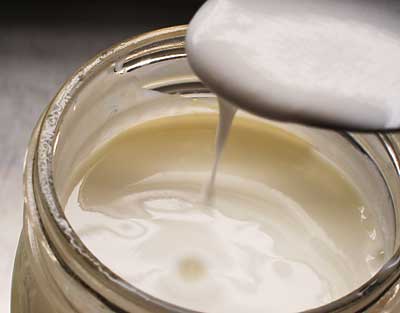Would you like some Kefir? Like some what?!
Not long ago my father had mentioned this thing called ‘kefir’ with which you could apparently make yoghurt. At the time I didn’t pay much attention and he, despite mentioning that this kefir thing could be obtained for free (or just by paying postage), didn’t make much of it either. It was not until recently, when I travelled to Russia (where it is very popular) that I finally got in close contact with ‘kefir’.
Read on to learn more about kefir.
So what is kefir, really?
‘Kefir’ is often used to refer to one of two things: either the grains that make kefir milk or the kefir milk itself. The grains look very much like tapioca pearls that have been soaked in water. They are spongy, clump together, but they have a massive difference from tapioca pearls: they’re alive! No seriously, kefir grains are simply clumps of symbiotic colonies composed of yeasts and bacterias. That doesn’t sound very inviting, does it!

Kefir grains – image courtesy of Wikipedia
But it is! After spending a few days in Russia and finding kefir milk in almost every restaurant (and drinking it with almost every meal), it started growing in me (pun totally and shamefully intended!). When I came back I decided to investigate what was kefir. What I found out was a barrage of health benefits that are traditionally associated with it. Some people call kefir a super probiotic drink. You know the off-the-shelf yoghurt that promises L. Casei Imunitass as providing you with marvelous bacteria for your intestinal tract? Well, kefir (when home made, not bought at the store) contains more than SEVENTY different strains of beneficial bacteria for your intestines. Are you sold yet? I was, after the SEVENTY.
Now comes the best part. Like I mentioned in the very beginning of this post, kefir can be obtained for free. Now, that’s not the kefir milk but the grains that ferment fresh milk into kefir milk. These grains are given away for free by some people because as soon as you start making kefir milk daily, the grains will start growing like there’s no tomorrow. Yes! The grains grow in size!
How do I get it?
After obtaining a small mother colony off Marktplaats for a mere 1 euro plus 1 euro postage, I’ve started making it and drinking it every day. My only problem right now? I have too many kefir grains! Would you like some? Then please drop me a comment with your e-mail address and I’ll be in touch!
Want to learn more?
I could spend a whole day writing about how to ferment your kefir milk and discussing best and worst techniques but all of that would be in vain. All of this information can be found on what’s the most comprehensive guide to kefir: Dom’s website. He describes in detail what kefir is and how to successfully ferment your milk (and water and coconut milk!) with your kefir grains. Be sure to visit his website as it is the reference to anyone who aspires to make his own kefir!


Comments